Newly detected sound signal could finally solve the mystery of MH370 after 10 years
The mystery surrounding the lost Malaysia Airlines flight MH370 could soon be solved after British investigators found a signal that could lead them to the plane’s final resting place after a decade.
Underwater microphones, also known as hydrophones, reportedly picked up a signal around the same time as the MH370 crash on March 8, 2014.
The six-second signal was discovered by researchers from Cardiff, who reportedly said further tests would be needed to determine whether the sounds the microphones recorded could lead to the plane’s crash site.
The plane, with 239 people on board, reportedly ran out of fuel and tragically crashed into the Indian Ocean after deviating from its course from Kuala Lumpur to Beijing for unknown reasons.
Despite extensive searches over an area of 46,332 square kilometers by authorities from around the world, the plane’s resting place has remained a mystery for the past decade.
March 8, 2024 marked ten years since Malaysia Airlines flight MH370, from Kuala Lumpur to Beijing, went missing shortly after takeoff. The flight is believed to have crashed somewhere in the southern Indian Ocean (an image of the crash is shown in the photo)
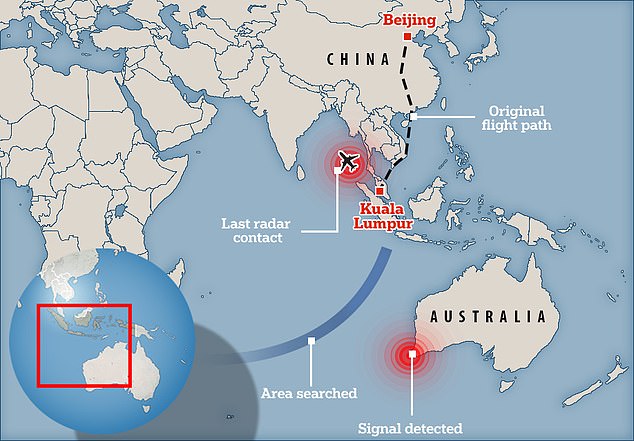
Underwater microphones, also called hydrophones, near the coast of Western Australia reportedly picked up a signal around the same time as the MH370 crash on March 8, 2014.

To mark the tenth anniversary of the disappearance of MH370, as many as 500 relatives of victims lost during the flight gathered at a shopping center in the Malaysian city of Subang Jaya for a service on March 8, 2024.
Since then, some fragments of the plane have been discovered and a number of theories have emerged about what – and who – caused the flight’s course change, but no one really knows without a doubt what happened to the Boeing 777.
In the week leading up to the tenth anniversary of the disappearance of MH370 earlier this year, the Malaysian government supported a new ‘no find, no fee’ search off the coast of Australia, but this was once again unsuccessful.
The starting point for the researchers in Cardiff was the assumption that a 200-ton aircraft like MH370 would release as much kinetic energy as a small earthquake if it crashed at a speed of 200 meters per second.
This kinetic energy would have been great enough to be recorded by underwater microphones thousands of kilometers away, two of which – at Cape Leeuwin in Western Australia and in the British territory of Diego Garcia – were close enough to detect such a signal .
The operational stations are set up to detect violations of the Comprehensive Test Ban Treaty and are only a few tens of minutes of signal travel time from where the aircraft’s last radar contact occurred.
The newly detected signal, which was detected in the time window when the plane could have crashed, was only recorded at the Cape Leeuwin stations, which “raises questions about its origins,” researcher Dr Usama Kadri told the Telegraph.
Dr. Kadri, whose expertise is in applied mathematics, said that while the signal measurement was inconclusive, it was “highly unlikely” that the sensitive hydrophones would not have picked up the impact of a large aircraft crashing into the ocean.
His team believes that further research into the newly detected signal could eventually solve the mystery, just as hydrophones helped locate the ARA San Juan, an Argentine Navy submarine that was found on the ocean floor of the South Atlantic Ocean. years after it imploded and disappeared. .
To locate the wreckage, researchers used grenades to simulate the explosion on the submarine and compared that signal to the signal picked up by hydrophones as it imploded.
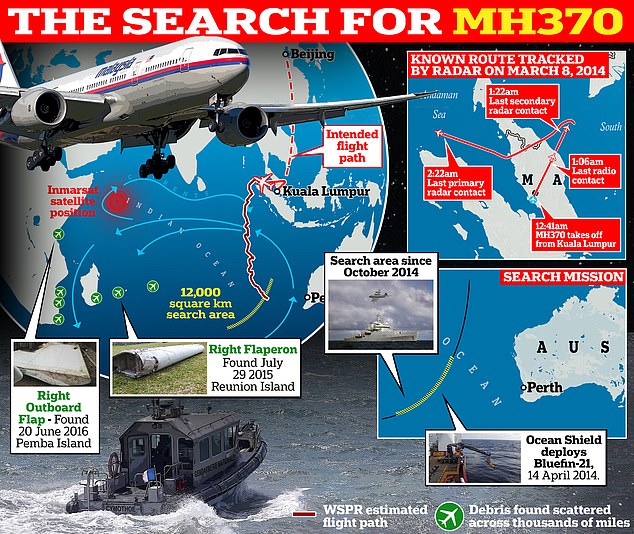
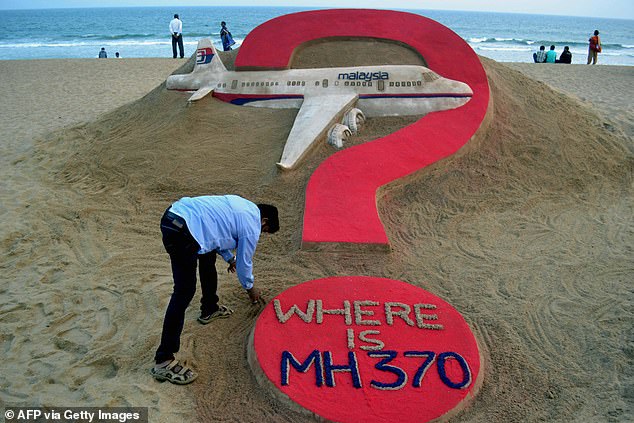
Indian sand artist Sudarsan Pattnaik creates a sand sculpture of the missing Malaysia Airlines flight MH370 at Puri beach in the eastern state of Odisha on March 7, 2015
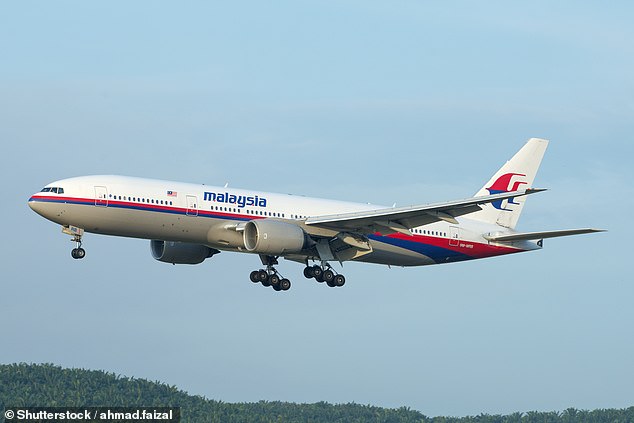
The Malaysia Airlines plane lost contact with air traffic control within an hour of taking off from Kuala Lumpur International Airport
This eventually led them to the remains of the ARA San Juan, which was located 470 miles off the coast of Argentina, almost 3,000 feet below the surface.
Dr. Kadri suggested that a similar experiment could be carried out to find the wreckage of MH370. Should such explosions exhibit similar pressure amplitudes to the detected signal, “this could help focus future searches on that signal.”
He told the Telegraoph: ‘If the signals detected at both Cape Leeuwin and Diego Garcia are much stronger than the signal in question, further analysis of the signals from both stations would be necessary.
“If there turns out to be a connection, it would significantly narrow down, almost pinpoint, the location of the aircraft.”
But if the signal turns out to be unrelated, Dr. Kadri said it would show that authorities may need to reassess the location and time frame of the expected crash, which have been used as a starting point in their searches so far.
This is not the first time Britain has helped narrow the search area for flight MH370.
As evidence began to point to the plane flying west after communications were lost, London-based satellite company Immarsat discovered that one of its satellites was receiving signals from MH370 every hour for seven hours after it disappeared from military radar.
While this confirmed that MH370 had been in the air for even longer than initially thought, the plane’s location could not be tracked.
It was also only at this point that the time of MH17’s disappearance from military radars was revealed as 2:22 am – over the Andaman Sea, somewhere west of the original search area.
Immarsat’s data was able to calculate an estimate of the plane’s position based on how long the transmissions between the plane and the satellite took, and it provided a rough area after which the plane could have lost fuel or crashed.
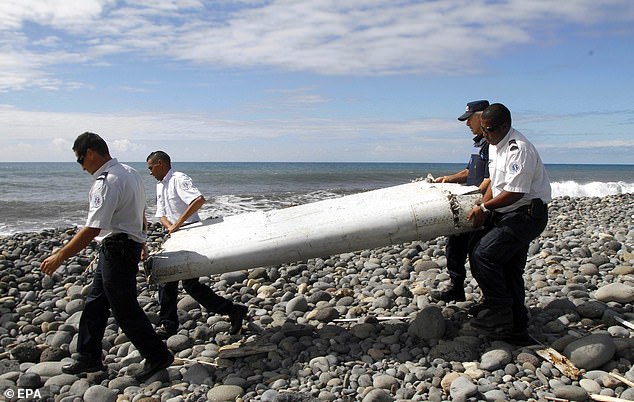
A piece of MH370’s wing found on Réunion, a French island east of Madagascar, in July 2015
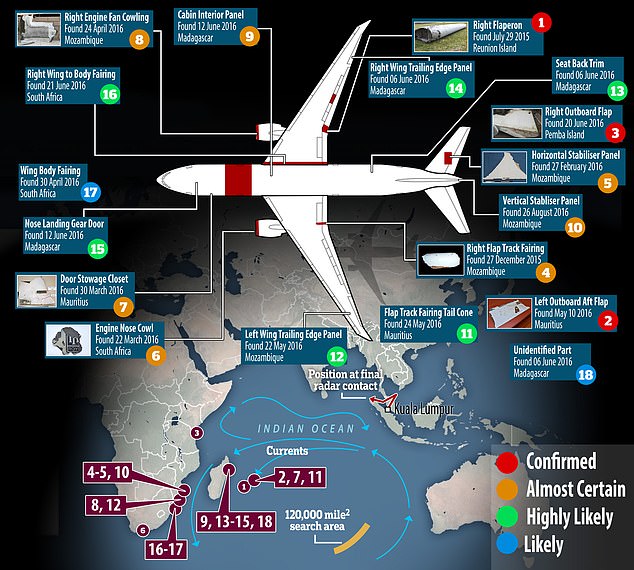
By October 2017, 18 suspected pieces of MH370 had been found
This turned out to be an arc stretching from Central Asia north to Antarctica, about eight hours after takeoff.
Because the north of that area consisted of heavily militarized airspace that would have detected MH17, it was considered very likely that MH370 had crashed in the Indian Ocean.
It is believed the plane nose-dived or crashed in the minutes after 8:19 a.m. on March 8.
More than a year later, in 2015, Malaysian Prime Minister Najib Razak says that a wing part that washed up on Réunion – a French island east of Madagascar – came from MH370.
Over the next two years, a further 17 pieces of debris were found and ‘identified as very likely or almost certainly from MH370’, while a further two ‘were assessed as likely from the accident aircraft’.
